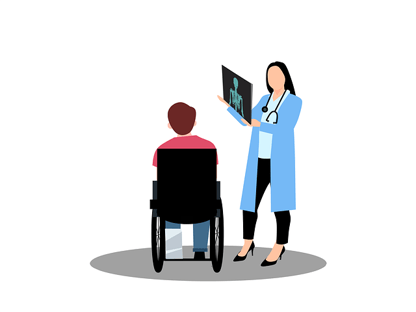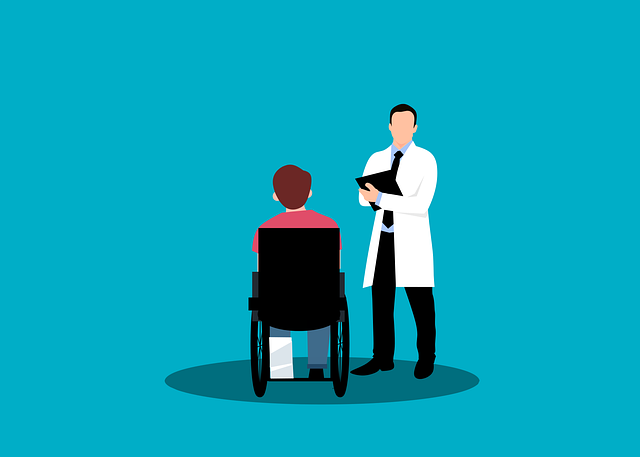December 21, 2023
Physical Therapy ICD-10 Codes: A Comprehensive Guide
Welcome, fellow physical therapy professionals! In the dynamic landscape of healthcare, it's crucial for us to stay on top of the latest coding standards to ensure accurate documentation and reimbursement for our services.
In this comprehensive guide, we'll delve into everything you need to know about physical therapy ICD-10 codes and their relevance to our practice.
The Evolution: From ICD-9 to ICD-10
 As dedicated healthcare providers, we've transitioned from the era of ICD-9 to the more sophisticated ICD-10. Released by the World Health Organization in 1992, ICD-10 offers a vast improvement in specificity, with approximately 69,000 codes compared to ICD-9's 13,000. The transition became mandatory for all HIPAA-covered entities, including us, rehab therapists.
As dedicated healthcare providers, we've transitioned from the era of ICD-9 to the more sophisticated ICD-10. Released by the World Health Organization in 1992, ICD-10 offers a vast improvement in specificity, with approximately 69,000 codes compared to ICD-9's 13,000. The transition became mandatory for all HIPAA-covered entities, including us, rehab therapists.
Why the Change?
ICD-10 isn't just an upgrade - it's a game-changer. The multitude of codes allows us, as rehab therapists, to document patient diagnoses with unparalleled precision. This facilitates evidence-based practice, optimizes grouping and reimbursement processes, and promotes seamless data exchange across healthcare platforms.
Understanding the ICD-10 Code Structure
Let’s examine how ICD-10 codes work, discover the seventh character, and grasp the structure that provides nuanced details crucial to accurate documentation in physical therapy.
Code Anatomy
The architecture of ICD-10 codes represents a significant departure from the familiar structure of ICD-9. In ICD-10, the codes are not just a string of numbers but a nuanced combination of alphanumeric characters, offering a substantial increase in specificity.
Let's delve into the intricacies of the code anatomy to understand the evolution from ICD-9 to ICD-10.
- Length and Complexity: ICD-10 codes can range from three to seven characters, allowing for a much finer level of granularity in coding patient diagnoses. This is a substantial leap from the limitations of ICD-9, which had three to five characters.
- Alphanumeric Combination: The alphanumeric nature of ICD-10 codes brings a new layer of sophistication. For instance, let's compare the ICD-9 code 813.15 with its ICD-10 counterpart, M96.831. The transition is not merely about expanding the number of characters but introducing letters into the mix, adding a new dimension to the coding system.
- Distinct from CPT Codes: It's crucial to emphasize that ICD-10 codes and Current Procedural Terminology (CPT) codes are distinct entities. While ICD-10 captures the specificity of patient diagnoses, CPT codes focus on procedures and services provided. The adoption of ICD-10 does not disrupt the use of CPT codes, and they continue to play a pivotal role in documenting the procedures performed.
- Illustrative Comparison: Consider the visual contrast between ICD-9's numerical sequence 813.15 and ICD-10's alphanumeric composition M96.831. This transformation underscores the enhanced capacity of ICD-10 to capture a broader array of clinical nuances and details in a single code.
The 7th Character
In the transition from ICD-9 to ICD-10, one of the notable enhancements is the introduction of the seventh character. Unlike its predecessor, this character serves a pivotal role in providing additional details, particularly for injuries and specific medical conditions. It acts as a crucial piece of the coding puzzle, offering insights that contribute to a more comprehensive understanding of the patient's situation.
Noteworthy, however, is that not every ICD-10 code necessitates the inclusion of the seventh character. The decision to use it depends on the specific coding guidelines outlined for each chapter.
For instance, when dealing with injuries, adherence to this character is obligatory for Chapter 19 (Injury, poisoning, and certain other consequences of external causes) and Chapter 15 (Pregnancy, childbirth, and the puerperium) codes.
Examples in Action: Decoding S86.011D
To illustrate the significance of the seventh character, let's dissect the code S86.011D, which denotes a subsequent encounter for a strain of the right Achilles tendon. Each character within this alphanumeric sequence serves a distinct purpose, unraveling a detailed narrative of the patient's condition.
- S: The first character designates the category, in this case, "Injuries, poisoning and certain other consequences of external causes related to single body regions."
- 86: This numeric sequence further specifies the category, pinpointing the diagnosis as "Injury of muscle, fascia, and tendon at the lower leg."
- .011: The characters three through six delve into the etiology, anatomic site, severity, or other vital clinical details. In this instance, the numbers "011" precisely indicate a diagnosis of "Strain of the right Achilles tendon."
- D: Lastly, the seventh character, "D," signifies that this is a subsequent encounter. It communicates that the patient is receiving routine care for the injury during the healing or recovery period, often involving rehabilitation therapy.
This meticulous breakdown showcases how each character in the ICD-10 code contributes to a nuanced and granular description of the patient's condition. It's this level of specificity that not only aligns with the precision demanded by ICD-10 but also elevates the quality of documentation, paving the way for improved patient care, research initiatives, and seamless data exchange across healthcare platforms.

Most Common Physical Therapy ICD-10 Codes List
Learn when and why to refer patients based on specific conditions, and explore the relevant ICD-10 codes for physical therapy in the R26, R62, F82, M43.6, and M62.81 series, ensuring precise and effective communication in your practice.
Here are the most common ICD-10 codes for physical therapy:
R26 Series: Abnormalities of Gait and Mobility
When to Refer: Children with walking abnormalities, toe-walking, or feet turning excessively.
Relevant Codes:
- R26.2 - Difficulty in walking, not elsewhere classified
- R26.8 - Other abnormalities of gait and mobility
- R26.81 - Unsteadiness on feet
- R26.89 - Other abnormalities of gait and mobility
- R26.9 - Unspecified abnormalities of gait and mobility
R62 Series: Delayed Milestone in Childhood
When to Refer: Children not meeting gross motor skill milestones due to a medical diagnosis.
Relevant Codes:
- R62.0 - Delayed milestone in childhood
- R62.5 - Other and unspecified lack of expected normal physiological development in childhood
F82 Series: Specific Developmental Disorders of Motor Function
When to Refer: Children not meeting gross motor skills without an underlying medical diagnosis.
Relevant Codes:
- F82.0 - Specific developmental disorder of motor function
M43.6 Torticollis
When to Refer: Observation or parent report of consistent head turning or tilting.
Relevant Codes:
- M43.6 - Torticollis
M62.81 Muscle Weakness (Generalized)
When to Refer: Children struggling with physical tasks, seeking support frequently, or reporting pain.
Relevant Codes:
- M62.81 - Muscle weakness (generalized)
List of Physical Therapy ICD-10 Codes
This expanded list covers a wide range of conditions that physical therapists frequently encounter, providing a valuable resource for accurate ICD-10 coding.
| Category | Condition | ICD-10 Code | Description |
| Abnormalities of Gait and Mobility | Difficulty in walking | R26.2 | Difficulty in walking, not elsewhere classified |
| Other abnormalities of gait and mobility | R26.89 | Other abnormalities of gait and mobility | |
| Unsteadiness on feet | R26.81 | Unsteadiness on feet | |
| Unspecified abnormalities of gait and mobility | R26.9 | Unspecified abnormalities of gait and mobility | |
| Delayed Milestone in Childhood | Delayed milestone in childhood | R62.0 | Delayed milestone in childhood |
| Other lack of expected normal physiological development in childhood | R62.5 | Other and unspecified lack of expected normal physiological development in childhood | |
| Specific Developmental Disorders | Specific developmental disorder of motor function | F82.0 | Specific developmental disorder of motor function |
| Muscle Weakness | Muscle weakness (generalized) | M62.81 | Muscle weakness (generalized) |
| Torticollis | Torticollis | M43.6 | Torticollis |
| Other Musculoskeletal Conditions | Low back pain | M54.5 | Low back pain |
| Cervicalgia | M54.2 | Pain in the neck | |
| Lumbago with sciatica | M54.4 | Lumbago with sciatica | |
| Joint Disorders | Osteoarthritis of knee | M17.11 | Unilateral primary osteoarthritis, right knee |
| Osteoarthritis of hip | M16.11 | Unilateral primary osteoarthritis, right hip | |
| Osteoarthritis of shoulder | M19.011 | Primary osteoarthritis, right shoulder | |
| Fractures and Dislocations | Fracture of the femur | S72.001A | Fracture of unspecified part of neck of right femur, initial encounter |
| Dislocation of shoulder | S43.001A | Unspecified dislocation of right shoulder joint, initial encounter | |
| Injuries and Sprains | Sprain of the anterior cruciate ligament of knee | S83.511A | Sprain of anterior cruciate ligament of right knee, initial encounter |
| Sprain of the rotator cuff capsule | S43.421A | Sprain of rotator cuff capsule of right shoulder, initial encounter | |
| Achilles tendon strain | S86.011A | Strain of right Achilles tendon, initial encounter |
Practical Tips for Implementation of Physical Therapy ICD-10 Codes

1. Ensuring Accuracy and Preventing Denials
In the dynamic realm of ICD-10 implementation, accuracy is the linchpin.
Consider these practical tips to navigate the coding landscape effectively:
- Specificity is Key: The essence of ICD-10 lies in specificity. Be meticulous in your coding, ensuring that each code chosen paints a detailed and accurate picture of the patient's diagnosis. Precision not only supports optimal patient care but also safeguards against claim denials.
- Regular Code Audits: As a vigilant practitioner, conduct regular audits of your codes. Whether you've embraced an Electronic Medical Record (EMR) system or not, the responsibility rests on your shoulders to verify that the codes align seamlessly with your documentation. This practice becomes even more critical in the absence of an intelligent ICD-10 tool within your EMR.
- Stay Informed: The coding landscape is ever-evolving. Stay informed about the latest nuances in ICD-10. Regular updates ensure that you're equipped to navigate any changes in the coding system, contributing to a smoother workflow.
- Choose the Right EMR: Opting for a reliable EMR can significantly streamline your coding process. PtEverywhere, a Practice Management software designed for physical therapists, not only prompts detailed patient condition documentation but also suggests specific codes when greater specificity exists. This feature is invaluable in enhancing the accuracy of your coding efforts.
2. The CMS Grace Period
The CMS grace period, spanning from October 1, 2015, to September 30, 2016, was a respite for healthcare providers. During this time, Medicare review contractors showed leniency by not denying claims solely based on code specificity.
However, it's crucial to recognize that this grace period is a thing of the past. Post-grace period, specificity is the linchpin for avoiding claim denials.
3. The Role of Documentation
ICD-10 codes wield substantial power, but their efficacy hinges on robust supporting documentation. Here's why documentation plays a pivotal role:
- Communicating Intent: Quality clinical documentation is not just a formality - it's a means of clearly communicating the intent of an encounter. The why, what, and how of patient care should be evident in your documentation.
- Confirming Medical Necessity: ICD-10 codes should align seamlessly with the medical necessity of the provided services. Thorough documentation serves as a corroborative tool to substantiate the necessity of the chosen codes.
- Supporting Code Selection: The codes you select should find unwavering support in your documentation. The relationship between the clinical scenario and the assigned codes should be evident, ensuring transparency and accuracy.
As you traverse the intricacies of ICD-10, adherence to these practical tips, along with the assistance of PtEverywhere, can elevate the accuracy of your coding endeavors and contribute to a seamless and efficient workflow.
Looking Ahead: ICD-11 and Further Learning
While ICD-10 reigns supreme for now, its successor lurks on the horizon. In 2018, the World Health Organization released ICD-11, heralding a new era in medical classification. Though initially slated for 2022, most experts predict a later rollout, possibly closer to 2025. Given the lengthy US transition to ICD-10, a gradual shift seems likely, leaving ample time for preparation.
So, what awaits us in ICD-11? Buckle up, because it's not just a fresh coat of paint. The most notable change revolves around the coding scheme itself. Unlike the three-character categories of ICD-10, ICD-11 embraces a four-character system with an alpha-numeric twist.
Imagine this: say goodbye to codes like "M54.5"! Instead, we'll encounter more intuitive strings like "3C.21", where the first character reflects the chapter, the second an alpha element, and the third always a number. This revamped structure promises enhanced precision and clarity, streamlining the documentation process for healthcare professionals.
While the transition may hold a tinge of trepidation, remember, we've navigated ICD-10 before. By utilizing available resources and staying informed, we can approach ICD-11 with confidence, ushering in a new era of accurate and efficient medical communication.
Frequently Asked Questions
Why Are ICD-10 Codes Important for Physical Therapists?
ICD-10 codes are critical for physical therapists to document patient diagnoses accurately and ensure proper reimbursement. These codes provide detailed descriptions of conditions, helping therapists justify their treatment plans. Using the correct ICD-10 code for left shoulder pain or similar conditions improves billing efficiency and reduces claim denials.
How Do You Choose the Right ICD-10 Code?
Selecting the right ICD-10 code starts with a thorough evaluation of the patient’s condition. For instance, the ICD-10 code for pain in left shoulder, M25.512, is commonly used when a patient reports localized shoulder discomfort without a specific underlying diagnosis. If the condition is more specific, such as a rotator cuff tear, a related code like M75.112 may be more appropriate. Accurate documentation ensures the chosen code reflects the patient’s diagnosis and supports medical necessity.
What Are Some Commonly Used ICD-10 Codes in Physical Therapy?
Here are a few frequently used ICD-10 codes in physical therapy that therapists should be familiar with:
- R26.2 – Difficulty in walking, not elsewhere classified
- M54.5 – Low back pain
- M62.81 – Muscle weakness (generalized)
- M25.512 – Pain in left shoulder
Each code serves a unique purpose, from addressing mobility challenges to diagnosing joint and muscle conditions, ensuring tailored treatment plans for patients.
How Can ICD-10 Codes Be Used for Better Patient Outcomes?
Beyond billing, ICD-10 codes guide physical therapy strategies. By accurately coding conditions like M43.6 (Torticollis) or R62.0 (Delayed milestone in childhood), therapists can track progress over time and adjust interventions to meet patient goals. These codes also facilitate interdisciplinary communication, ensuring a cohesive approach to care.
Bottom Line
Mastering the intricacies of physical therapy ICD-10 codes is not just a professional requirement but a pathway to elevating patient care. As we've navigated the depths of ICD-10, unraveling its structure, understanding the significance of the seventh character, and preparing for the future with insights into ICD-11, the journey has been one of continuous learning and adaptation.
To streamline this process, consider leveraging PtEverywhere, a practice management software designed with the unique needs of physical therapists in mind. From facilitating accurate documentation to offering real-time updates on coding nuances, PtEverywhere emerges as a reliable ally on your journey towards excellence.


